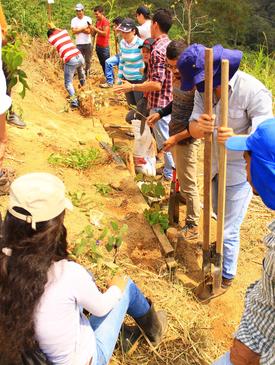Ecological Restoration of Severely Eroded Lands in Santander
Summary
Landslides and gullies are common forms of land degradation in the densely populated Colombian Andes. Mass movements in unstable areas pose a serious threat to local populations and cause off-site environmental damage through sedimentation, pollution and increased flooding. Road landslides hinder the mobility of people and agricultural products and are a latent risk for local communities in mountain areas. A novel approach for restoring severely eroded lands combines the use of soil stabilization structures with high-density planting of species that exhibit quick growth and sprouting.
This course seeks to increase awareness of the complex socio-environmental problems caused by severe erosion and expand the knowledge of participants on the principles and practices of the restoration of unstable lands. Erosion and mass movements demand the creative integration of disciplines to generate efficient and sustainable solutions. This course is supported by ELTI's Leadership Program through a small grant assigned to alumni Melisa Ayala and Mauricio Carvajal.
Content
Day 1 (main theater of Zapatoca):
- Historical and geological context of Zapatoca
- Ecological restoration for sustainable development in landscapes affected by erosion and landslides
- Reducing risk and enhancing quality of life through restoration: social participation, soil bioengineering and strategic use of native plants for the stabilization of eroded lands
- Case studies: pilot slopes in the road network of Antioquia and the Amoyá river basin (Tolima)
- Risk studies in land-use plans: the potential of ecological restoration from a civil engineering perspective
Days 2 and 3 (Nirvana Nature Reserve):
Field exercises, including:
- Design of a restoration project
- Construction of soil bioengineering structures
- Selection, sowing and spatial distribution of native plants for restoration


